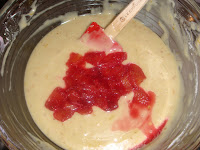
The New York Times is one of my favorite places to find new recipes. I enjoy them because they usually are accompanied by some sort of story of how the recipe evolved whether it be a dietary restriction, as in the case of this recipe, a seasonal ingredient, a family heirloom, or just the health benefits of a certain ingredient. Not only that, and most importantly, most of the recipes I have found here actually appeal to me more often than not. Furthermore, they don't disappoint.
I was intrigued by this recipe because it uses olive oil as the fat base. I can't remember a time when I've ever used olive oil in a sweet recipe so I decided why not now? I also just love using blood oranges, more for their look than taste. Something about the red flesh contrasting against the orange skin and white pith is very aesthetically pleasing. I took some pictures of my own but haven't had time to upload them. So here's a fancy one from Andrew Scrivani for The New York Times.
The result was a very moist cake. Three days later the cake is tastes as it did the first day - moist, rich, and full of citrus.
Ingredients
- Butter for greasing pan
- 3 blood oranges
- 1 cup sugar
- Buttermilk or plain yogurt ( I used yogurt, roughly 1/3rd cup)
- 3 large eggs
- 1 3/4 cups all-purpose flour
- 1 1/2 teaspoons baking powder
- 1/4 teaspoon baking soda
- 1/4 teaspoon salt
- 2/3 cup extra virgin olive oil
- dash of nutmeg
- Sugar glaze, optional (see note)
- Honey-blood orange compote, for serving, optional (see note)
- Whipped cream, for serving, optional.
1. Preheat oven to 350 degrees. Grease a 9-by-5-inch loaf pan. Grate zest from 2 oranges and place in a bowl with sugar. Using your fingers, rub ingredients together until orange zest is evenly distributed in sugar.
2. Supreme an orange: Cut off bottom and top so fruit is exposed and orange can stand upright on a cutting board. Cut away peel and pith, following curve of fruit with your knife. Cut orange segments out of their connective membranes and let them fall into a bowl. Repeat with another orange. Break up segments with your fingers to about 1/4-inch pieces.
3. Halve remaining orange and squeeze juice into a measuring cup. You will have about 1/3 cup or so. Add buttermilk or yogurt to juice until you have 2/3 cup liquid altogether. If using yogurt, as I did, make sure to whisk the yogurt into the liquid so you have an accurate reading. Pour mixture into bowl with sugar and whisk well. Whisk in eggs.
4. In another bowl, whisk together flour, baking powder, baking soda and salt. Add a dash of nutmeg and season to your preference. Gently whisk dry ingredients into wet ones. Switch to a spatula and fold in oil a little at a time. Fold in pieces of orange segments. Scrape batter into pan and smooth top.
5. Bake cake for about 50 minutes, or until it is golden and a knife inserted into center comes out clean. Cool on a rack for 5 minutes, then unmold and cool to room temperature right-side up.
Here the NYT suggested serving with whipped cream and honey-blood orange compote. I, however, made a glaze instead of 10x sugar combined with a touch of almond extract. I then added water until I got it to a slightly runny consistency. Poke some holes in the cake after it comes out of the oven and then drizzle the sugar mix on. After a few minutes it should harden forming a sugary shell on top.
Yield: 8 to 10 servings.
Note: To make a honey-blood orange compote, supreme 3 more blood oranges according to directions in Step 2. Drizzle in 1 to 2 teaspoons honey. Let sit for 5 minutes, then stir gently.
Boun Appetito!
-Lindsay




No comments:
Post a Comment